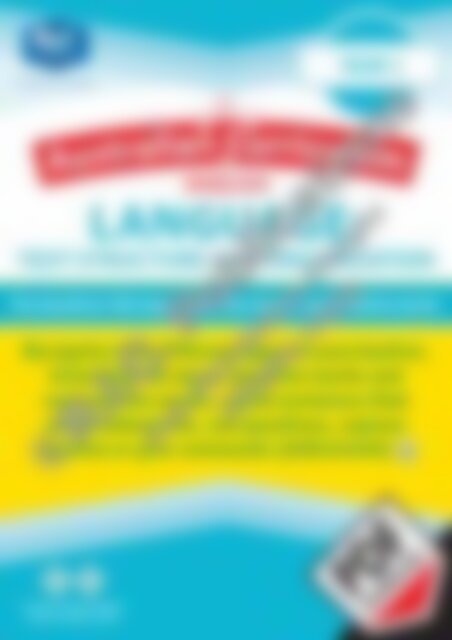20877 ACE Language (Yr 1) Full stops Question marks Exclamation Marks
You also want an ePaper? Increase the reach of your titles
YUMPU automatically turns print PDFs into web optimized ePapers that Google loves.
Your partner in education<br />
YEAR 1<br />
ENGLISH<br />
LANGUAGE:<br />
TEXT STRUCTURE AND ORGANISATION<br />
Punctuation: full <strong>stops</strong>, question <strong>marks</strong>, exclamation <strong>marks</strong><br />
Recognise that different types of punctuation,<br />
including full <strong>stops</strong>, question <strong>marks</strong> and<br />
exclamation <strong>marks</strong>, signal sentences that<br />
make statements, ask questions, express<br />
emotion or give commands (<strong>ACE</strong>LA1449)<br />
Australian Primary Publisher<br />
of the Year 2015 and 2016
Australian Curriculum English – <strong>Language</strong>: Text structure and organisation (Year 1)<br />
Foreword<br />
Australian Curriculum English – <strong>Language</strong>: Text structure and organisation (Year 1) is one in a series of seven teacher<br />
resource books that support teaching and learning activities in Australian Curriculum English. The books focus on<br />
the sub-strand of Text structure and organisation within the <strong>Language</strong> strand of the national English curriculum.<br />
The resource books include theoretical background information, activities to develop the content descriptions, blackline<br />
masters, resource sheets and assessment checklists, along with interrelated links to other English strands and sub-strands.<br />
Titles in this series are:<br />
• Australian Curriculum English – <strong>Language</strong>: Text structure and organisation (Foundation)<br />
• Australian Curriculum English – <strong>Language</strong>: Text structure and organisation (Year 1)<br />
• Australian Curriculum English – <strong>Language</strong>: Text structure and organisation (Year 2)<br />
• Australian Curriculum English – <strong>Language</strong>: Text structure and organisation (Year 3)<br />
• Australian Curriculum English – <strong>Language</strong>: Text structure and organisation (Year 4)<br />
• Australian Curriculum English – <strong>Language</strong>: Text structure and organisation (Year 5)<br />
• Australian Curriculum English – <strong>Language</strong>: Text structure and organisation (Year 6)<br />
Contents<br />
Format of this book .................................. iv – v<br />
<strong>Language</strong>: Text structure and<br />
organisation .............................................. 2–85<br />
Understand that the purposes texts serve shape their<br />
structure in predictable ways (<strong>ACE</strong>LA1477)<br />
© Australian Curriculum: Assessment and Reporting Authority 2012<br />
–Teacher information ................................................. 2<br />
–Activities to develop the content description ...... 3–10<br />
–Blackline masters ............................................. 11–25<br />
–Assessment checklist ............................................. 26<br />
–Interrelated English links ........................................ 27<br />
– Modes, capabilities and priorities covered by the<br />
activities in this content description ....................... 27<br />
Understand patterns of repetition and contrast in<br />
simple texts (<strong>ACE</strong>LA1448)<br />
© Australian Curriculum: Assessment and Reporting Authority 2012<br />
–Teacher information ............................................... 28<br />
–Activities to develop the content description .......... 29<br />
–Blackline masters and resource sheets .............. 30–51<br />
–Assessment checklist ............................................. 52<br />
–Interrelated English links ........................................ 53<br />
– Modes, capabilities and priorities covered by the<br />
activities in this content description ....................... 53<br />
Recognise that different types of punctuation, including full<br />
<strong>stops</strong>, question <strong>marks</strong> and exclamation <strong>marks</strong>, signal<br />
sentences that make statements, ask questions, express<br />
emotion or give commands (<strong>ACE</strong>LA1449)<br />
© Australian Curriculum: Assessment and Reporting Authority 2012<br />
–Teacher information ............................................... 54<br />
–Activities to develop the content description ......... 55<br />
–Blackline masters and resource sheets ............. 56–69<br />
–Assessment checklist ............................................. 70<br />
–Interrelated English links ........................................ 71<br />
– Modes, capabilities and priorities covered by the<br />
activities in this content description ....................... 71<br />
Understand concepts about print and screen, including how<br />
different types of texts are organised using page<br />
numbering, tables of content, headings and titles,<br />
navigation buttons, bars and links (<strong>ACE</strong>LA1450)<br />
© Australian Curriculum: Assessment and Reporting Authority 2012<br />
–Teacher information ............................................... 72<br />
–Activities to develop the content description .......... 73<br />
–Blackline masters and resource sheets ............. 74–83<br />
–Assessment checklist ............................................. 84<br />
–Interrelated English links ........................................ 85<br />
– Modes, capabilities and priorities covered by the<br />
activities in this content description ....................... 85<br />
Answers ................................................... 86–90<br />
R.I.C. Publications ® www.ricpublications.com.au Australian Curriculum English – <strong>Language</strong>: Text structure and organisation (Year 1)<br />
iii
Format of the book<br />
This teacher resource book includes supporting materials for teaching and learning in the sub-strand of Text structure and<br />
organisation within the strand of <strong>Language</strong> in Australian Curriculum English. All content descriptions in the sub-strand<br />
have been included, as well as teaching points based on the Curriculum’s elaborations.<br />
While the book focuses on the sub-strand of Text structure and organisation, activities and interrelated links to other<br />
strands and sub-strands have been incorporated.<br />
Each section supports a specific content description and follows a consistent format, containing the following information<br />
over several pages:<br />
• activities to develop the content descriptions • student blackline masters • resource sheets<br />
• interrelated English links<br />
• assessment checklist<br />
Answers relating to student blackline masters have been included at the back of the book.<br />
The length of each content description section varies.<br />
Teacher information includes background information relating to the content description, as well as<br />
related terms and desirable student vocabulary and other useful details which may assist the teacher.<br />
Related terms includes vocabulary<br />
associated with the content description.<br />
Many of these relate to the glossary<br />
in the back of the official Australian<br />
Curriculum English document;<br />
additional related terms may also have<br />
been added.<br />
Student vocabulary includes words<br />
which the teacher would use—<br />
and expect the students to learn,<br />
understand and use—during English<br />
lessons.<br />
Further resources by R.I.C.<br />
Publications or other publishers<br />
or authors are included where<br />
appropriate.<br />
?<br />
T<br />
E<br />
What this means<br />
provides a general<br />
explanation of the<br />
content description.<br />
Teaching points<br />
provides a list of<br />
the main teaching<br />
points relating to the<br />
content description.<br />
Elaborations are a<br />
list of elaborations<br />
based on those in the<br />
content description.<br />
Activities to develop the content<br />
description includes descriptions or<br />
instructions for activities or games<br />
relating to the content descriptions<br />
or elaborations. Some activities are<br />
supported by blackline masters or<br />
resource sheets. Where applicable,<br />
these will be stated for easy reference.<br />
Australian Curriculum English – <strong>Language</strong>: Text structure and organisation (Year 1) www.ricpublications.com.au R.I.C. Publications ®<br />
iv
Format of the book<br />
Blackline masters and resource<br />
sheets are provided to support<br />
teaching and learning activities<br />
for each content description.<br />
These include worksheets for<br />
class use, games, charts or other<br />
materials which the teacher might<br />
find useful to use or display in<br />
the classroom. For each blackline<br />
master or resource sheet, the<br />
content description to which it<br />
relates is given.<br />
Each section has a checklist<br />
which teachers may find useful as<br />
a place to keep a record of their<br />
observations of the activities to<br />
develop the content descriptions.<br />
Interrelated English links<br />
lists other links covered within<br />
the <strong>Language</strong> strand, Literature<br />
strand and Literacy strand of<br />
English that are incorporated in<br />
the activities provided with the<br />
content description. While the<br />
book’s approach focuses on the<br />
Text structure and organisation<br />
sub-strand, the links show the<br />
integration across the three<br />
strands.<br />
A table showing the <strong>Language</strong><br />
modes, General capabilities<br />
and Cross-curriculum priorities<br />
covered by the activities in each<br />
content description is provided.<br />
Answers for student worksheets<br />
are provided at the back of the<br />
book.<br />
R.I.C. Publications ® www.ricpublications.com.au Australian Curriculum English – <strong>Language</strong>: Text structure and organisation (Year 1)<br />
v
Text structure<br />
and organisation<br />
Recognise that different types of punctuation, including full <strong>stops</strong>, question <strong>marks</strong> and exclamation<br />
<strong>marks</strong>, signal sentences that make statements, ask questions, express emotion or give commands<br />
(<strong>ACE</strong>LA1449)<br />
© Australian Curriculum: Assessment and Reporting Authority 2012<br />
Related terms<br />
Punctuation/Punctuation <strong>marks</strong><br />
The system of inserting <strong>marks</strong> in text to clarify<br />
meaning. Punctuation <strong>marks</strong> include full <strong>stops</strong>,<br />
question <strong>marks</strong> and exclamation <strong>marks</strong>.<br />
Sentence<br />
A sentence is a group of words which convey a<br />
complete meaning and include a subject and a<br />
verb; e.g. Today (subject) is (verb) Wednesday.<br />
A sentence can also be called a statement, as<br />
opposed to a question.<br />
A written sentence begins with a capital letter<br />
and ends with a full stop, question mark or<br />
exclamation mark.<br />
<strong>Full</strong> stop<br />
Punctuation mark used to show the end of a<br />
sentence (statement); e.g. ‘I need a haircut.’<br />
<strong>Question</strong> mark<br />
Punctuation mark used to indicate a question;<br />
e.g. ‘What’s the time, please?’<br />
<strong>Exclamation</strong> mark<br />
Punctuation mark used at the end of a remark<br />
to show strong emotion or feeling; ‘Oh, no!’<br />
or when giving a concise command; e.g. ‘Don’t<br />
touch!’<br />
Intonation<br />
The rise or fall of voice in speaking.<br />
?<br />
T<br />
What this means<br />
Teacher information<br />
• Different types of punctuation <strong>marks</strong> at the end of sentences indicate whether it is a<br />
statement (use of full stop), a question (use of a question mark) or an exclamation<br />
(use of an exclamation mark).<br />
• Students need to identify full <strong>stops</strong>, question <strong>marks</strong> and exclamation mark in<br />
sentences and what each indicates.<br />
Teaching points<br />
• Students should identify that a sentence is a group of words which make sense by<br />
themselves. A line of writing is not necessarily a sentence. It may be simply be a<br />
group of random words, a caption or a heading.<br />
• Discuss punctuation <strong>marks</strong> such as full <strong>stops</strong>, question <strong>marks</strong> and exclamation<br />
<strong>marks</strong> in sentences students encounter in familiar and unfamiliar texts in class. Talk<br />
about the reason we have these standardised <strong>marks</strong>.<br />
• Punctuation is an important part of written text. Using the correct punctuation<br />
makes a difference to how a sentence is read and understood. Punctuation gives<br />
writing structure and organisation so a reader (or listener) understands the message<br />
conveyed by the writer.<br />
• Students should identify that punctuation <strong>marks</strong> are a guide to using the correct<br />
intonation and pauses when reading out loud. Frequent modelling by the teacher of<br />
reading sentences with different punctuation will assist students to identify and use<br />
the punctuation <strong>marks</strong> correctly. Points to note:<br />
– A full stop indicates the end of an idea or thought in a sentence (statement). It<br />
signals a break or pause is needed when reading. The voice goes down or stays<br />
the same when fi nishing a sentence.<br />
– A question mark indicates an interrogative statement, addressed to someone to<br />
fi nd out information. The voice is raised at the end.<br />
– An exclamation mark indicates strong feeling, such as surprise, excitement or<br />
anger or be used after a concise command. The voice is raised during all of the<br />
exclamation to show emphasis.<br />
sentence<br />
question<br />
Student vocabulary<br />
exclamation<br />
punctuation <strong>marks</strong><br />
capital letter<br />
full stop<br />
question mark<br />
exclamation mark<br />
R.I.C. Publications ® follows the guidelines for<br />
punctuation and grammar as recommended by the<br />
Style manual for authors, editors and printers, 6th<br />
edn., 2002.<br />
Note, however, that teachers should use their own<br />
guide if there is a conflict.<br />
E<br />
Elaborations<br />
E1. Identifi es full <strong>stops</strong>, question <strong>marks</strong> and exclamation <strong>marks</strong> in sentences.<br />
E2. Understands that punctuation <strong>marks</strong> in text are a guide to using the correct<br />
intonation and pauses when reading.<br />
E3. Uses full <strong>stops</strong>, question <strong>marks</strong> and exclamation <strong>marks</strong> correctly when writing<br />
sentences.<br />
Further resources<br />
• Primary grammar and word study (Book A) published by R.I.C. Publications<br />
• Fergus full stop by Barbara Cooper<br />
• Quentin question mark by Barbara Cooper<br />
• Ethel exclamation mark by Barbara Cooper<br />
(interactive game<br />
about adding full <strong>stops</strong>)<br />
(interactive game<br />
identifying sentences, questions and exclamations)<br />
Australian Curriculum English – <strong>Language</strong>: Text structure and organisation (Year 1) www.ricpublications.com.au R.I.C. Publications ®<br />
54
Text structure<br />
and organisation<br />
Recognise that different types of punctuation, including full <strong>stops</strong>,<br />
question <strong>marks</strong> and exclamation <strong>marks</strong>, signal sentences that make<br />
statements, ask questions, express emotion or give commands<br />
(<strong>ACE</strong>LA1449)<br />
© Australian Curriculum: Assessment and Reporting Authority 2012<br />
Activities to<br />
develop the<br />
content description<br />
E1. Identifies full <strong>stops</strong>, question <strong>marks</strong> and exclamation <strong>marks</strong> in sentences.<br />
• Introducing/Revising full <strong>stops</strong>, question <strong>marks</strong> and exclamation <strong>marks</strong><br />
Depending on what students have learnt previously, they made need to have each punctuation mark treated separately, rather than introduce/revise all<br />
at the same time. Some ideas are provided below.<br />
– Make cardboard cut outs of each in different coloured card—black for full <strong>stops</strong>, blue for question <strong>marks</strong> and red for exclamation <strong>marks</strong>. Attach<br />
Blu-Tack to the back. Explain each mark’s job: a full stop is a dot to show where a sentence <strong>stops</strong>. A question mark and exclamation also have a<br />
dot. A question mark has a squiggle above the dot to show it is a question and needs an answer. An exclamation mark has a straight line above the<br />
dot to show the sentence has strong feeling. Write sentences on a board or chart for students to attach the correct punctuation mark at the end.<br />
– Look at sentences in shared reading books and ask students to identify the full <strong>stops</strong>, question <strong>marks</strong> and exclamation <strong>marks</strong>.<br />
– Use physical activities to practise identifying punctuation <strong>marks</strong>. The teacher, chosen student or class read a sentence on the board or chart.<br />
Students curl into a ball if it has a full stop at the end, curl over if it has a question mark and stand up tall and straight if it has an exclamation<br />
mark.<br />
• Punctuation mark hunt<br />
– Tally the number of full <strong>stops</strong>, question <strong>marks</strong> and exclamation <strong>marks</strong> in a section of a class reader, shared book or other text. Discuss why there are<br />
(usually) more full <strong>stops</strong> than question <strong>marks</strong> and exclamation <strong>marks</strong>.<br />
– Use black, blue and red felt-tipped pens (refer to the activity in fi rst bullet point above) to trace over full <strong>stops</strong>, question <strong>marks</strong> and exclamation<br />
<strong>marks</strong> in recycled magazines and newspapers.<br />
• Punctuation <strong>marks</strong> resource sheets (pages 56 to 58)<br />
– Colour and enlarge the punctuation <strong>marks</strong> resource sheets and display for students to refer to.<br />
Interrelated English links: See page 71<br />
E2. Understands that punctuation <strong>marks</strong> in text are a guide to using the correct intonation and pauses<br />
when reading.<br />
• Modelling correct intonation and pauses<br />
Look at sentences in class readers and shared reading books and ask students to identify the full <strong>stops</strong>, question <strong>marks</strong> and exclamation <strong>marks</strong>. Model<br />
reading the sentences out loud for students to repeat, using the correct intonation and pauses. Refer to the fi nal bullet point in the ‘Teaching points’ on<br />
page 54.<br />
• How do you say it? (Game cards, pages 59 to 61)<br />
Punctuation cards and matching punctuation <strong>marks</strong> are provided for use in games. One student in a small group chooses a card from a pile placed facedown,<br />
without showing the others in the group. He or she reads the words on the card, using the correct intonation. (Teacher guidance may be needed.)<br />
Student to the left works out if a full stop, question mark or exclamation mark card is the correct one to choose. That student is the next to pick up a<br />
card from the pile. The group continues taking turns.<br />
• Playscripts (pages 62 to 63)<br />
Playscripts are texts that usually contain a mixture of sentences, questions and exclamations. Two have been provided for students to read and perform.<br />
Interrelated English links: See page 71<br />
E3. Uses full <strong>stops</strong>, question <strong>marks</strong> and exclamation <strong>marks</strong> correctly when writing sentences.<br />
• Sentence of the week<br />
Write a sentence on a board or thick strip of card every day. Students have to decide if it needs a full stop, question mark or exclamation mark.<br />
• Stimulus pictures (page 64)<br />
Enlarge, photocopy and cut out copies of the pictures of the characters (alien, clown, witch and dragon) on page 64. Distribute one to each student.<br />
They colour the picture and use it as a stimulus to write sentences, questions and exclamations about it, using the correct punctuation <strong>marks</strong>. Share and<br />
compare.<br />
• Using punctuation <strong>marks</strong> in sentences (pages 65 to 69)<br />
Pages 65 to 69 provide a variety of blackline masters students can use to practise writing their own sentences and identifying which punctuation <strong>marks</strong><br />
to use in given sentences. Note: Pages 66 and 67 deal with question <strong>marks</strong>. The words used in the activities are those that indicate a question is being<br />
asked. Students should understand that these words signal when to use a question mark.<br />
Interrelated English links: See page 71<br />
R.I.C. Publications ® www.ricpublications.com.au Australian Curriculum English – <strong>Language</strong>: Text structure and organisation (Year 1)<br />
55
FULL STOPS<br />
Resource sheet<br />
A full stop is used at the end of a sentence.<br />
For example:<br />
It was a sunny day.<br />
We went to the park.<br />
I played on the monkey bars.<br />
My sister went down the slide.<br />
Dad sat on the bench.<br />
Recognise that different types of punctuation, including full <strong>stops</strong>, question <strong>marks</strong> and exclamation <strong>marks</strong>, signal sentences that make statements, ask questions, express emotion or give commands<br />
(<strong>ACE</strong>LA1449) © Australian Curriculum: Assessment and Reporting Authority 2012<br />
Australian Curriculum English – <strong>Language</strong>: Text structure and organisation (Year 1) www.ricpublications.com.au R.I.C. Publications ®<br />
56
Recognise that different types of punctuation, including full <strong>stops</strong>, question <strong>marks</strong> and exclamation <strong>marks</strong>, signal sentences that make statements, ask questions, express emotion or give commands<br />
(<strong>ACE</strong>LA1449) © Australian Curriculum: Assessment and Reporting Authority 2012<br />
QUESTION MARKS<br />
A question mark is used at the end of a<br />
question.<br />
What is your name?<br />
How old are you?<br />
Where do you live?<br />
For example:<br />
What is your favourite colour?<br />
R.I.C. Publications ® www.ricpublications.com.au Australian Curriculum English – <strong>Language</strong>: Text structure and organisation (Year 1)<br />
57<br />
Resource sheet
EXCLAMATION MARKS<br />
An exclamation mark is used at the end<br />
of a exclamation.<br />
Watch out!<br />
Ouch!<br />
Don’t do that!<br />
Ready, set, go!<br />
For example:<br />
I hate eating broccoli!<br />
Resource sheet<br />
Recognise that different types of punctuation, including full <strong>stops</strong>, question <strong>marks</strong> and exclamation <strong>marks</strong>, signal sentences that make statements, ask questions, express emotion or give commands<br />
(<strong>ACE</strong>LA1449) © Australian Curriculum: Assessment and Reporting Authority 2012<br />
Australian Curriculum English – <strong>Language</strong>: Text structure and organisation (Year 1) www.ricpublications.com.au R.I.C. Publications ®<br />
58
Punctuation game cards – 1<br />
Resource sheet<br />
Recognise that different types of punctuation, including full <strong>stops</strong>, question <strong>marks</strong> and exclamation <strong>marks</strong>, signal sentences that make statements, ask questions, express emotion or give commands<br />
(<strong>ACE</strong>LA1449) © Australian Curriculum: Assessment and Reporting Authority 2012<br />
R.I.C. Publications ® www.ricpublications.com.au Australian Curriculum English – <strong>Language</strong>: Text structure and organisation (Year 1)<br />
59
Punctuation game cards – 2<br />
Resource sheet<br />
Recognise that different types of punctuation, including full <strong>stops</strong>, question <strong>marks</strong> and exclamation <strong>marks</strong>, signal sentences that make statements, ask questions, express emotion or give commands<br />
(<strong>ACE</strong>LA1449) © Australian Curriculum: Assessment and Reporting Authority 2012<br />
Australian Curriculum English – <strong>Language</strong>: Text structure and organisation (Year 1) www.ricpublications.com.au R.I.C. Publications ®<br />
60
Punctuation mark cards<br />
Resource sheet<br />
Recognise that different types of punctuation, including full <strong>stops</strong>, question <strong>marks</strong> and exclamation <strong>marks</strong>, signal sentences that make statements, ask questions, express emotion or give commands<br />
(<strong>ACE</strong>LA1449) © Australian Curriculum: Assessment and Reporting Authority 2012<br />
? ! . .<br />
? ! . .<br />
? ! ! .<br />
? ? ! .<br />
R.I.C. Publications ® www.ricpublications.com.au Australian Curriculum English – <strong>Language</strong>: Text structure and organisation (Year 1)<br />
61
A drink of water<br />
Resource sheet<br />
Scene: A family living room at night<br />
Props: chair, box to represent TV, two chairs pushed<br />
together for bed, rug, empty glass on floor, screen<br />
between ‘rooms’<br />
Characters: Dad, Ebony (characters can be changed to Mum or a<br />
son, change names to suit)<br />
(Dad is sitting in front of the television. Ebony is behind<br />
screen in bed.)<br />
Ebony: D-a-a-ad, I’m thirsty. Can I have a glass of water,<br />
please?<br />
Dad: No! You had a drink of water just five minutes ago,<br />
Ebony. Go to sleep! It’s way past your bedtime.<br />
(All is quiet for a few seconds.)<br />
Ebony: D-a-a-ad, I’m really thirsty! Could I have some water,<br />
please?<br />
Dad: Ebony, I already said ‘No!’ You don’t need any water.<br />
Go to sleep and don’t call out again!<br />
(This time it is quiet for a bit longer.)<br />
Ebony: D-a-a-ad …<br />
Dad: Ebony! Remember what I said.<br />
Ebony: Yes, Dad, I remember.<br />
Dad: Well, what is it then?<br />
Ebony: When you’re coming down to my room to be angry,<br />
could you bring me a glass of water, please?<br />
Recognise that different types of punctuation, including full <strong>stops</strong>, question <strong>marks</strong> and exclamation <strong>marks</strong>, signal sentences that make statements, ask questions, express emotion or give commands<br />
(<strong>ACE</strong>LA1449) © Australian Curriculum: Assessment and Reporting Authority 2012<br />
Australian Curriculum English – <strong>Language</strong>: Text structure and organisation (Year 1) www.ricpublications.com.au R.I.C. Publications ®<br />
62
Jack and Jill<br />
Resource sheet<br />
Recognise that different types of punctuation, including full <strong>stops</strong>, question <strong>marks</strong> and exclamation <strong>marks</strong>, signal sentences that make statements, ask questions, express emotion or give commands<br />
(<strong>ACE</strong>LA1449) © Australian Curriculum: Assessment and Reporting Authority 2012<br />
Scene: On a hill in the country<br />
Characters: Jack, Jill<br />
Props: plastic bucket, mat to roll on,<br />
long cushion for the log<br />
(Jill is waiting halfway up the<br />
‘hill’ for Jack. Jack is offstage.)<br />
Jill: Come on, Jack! Hurry up!<br />
Jack: Ok! I’m on my way. (He catches up to Jill.)<br />
Jill: Let’s fetch water as quickly as we can. Then we can<br />
have the rest of the day to play.<br />
Jack: I hate this hill! I’m sick of going up it every day to<br />
fetch water from the well.<br />
Jill: I hate it too! But if we didn’t go, we wouldn’t have<br />
any water to drink.<br />
Jack: I know. (He smiles and holds the bucket on top of his<br />
head.) Hey, Jill! Do you like my hat?<br />
Jill: Jack, stop wasting time! (She tries to grab the bucket.)<br />
Jack: (He bends over and holds the bucket on his back.)<br />
Now I’m a camel!<br />
Jill: Jack, watch out for that log!<br />
Jack: (Looking at Jill.) What log? (In slow motion and<br />
exaggerated expression and movement, he trips over the<br />
cushion.) Help! (He drops the bucket, falls over and rolls<br />
down the hill.)<br />
Jill: Jack, are you all right? (She puts her foot on the bucket.)<br />
Oh, no! (In slow motion and exaggerated expression, she<br />
falls over and rolls down the hill after him.)<br />
R.I.C. Publications ® www.ricpublications.com.au Australian Curriculum English – <strong>Language</strong>: Text structure and organisation (Year 1)<br />
63
Stimulus pictures<br />
Resource sheet<br />
Recognise that different types of punctuation, including full <strong>stops</strong>, question <strong>marks</strong> and exclamation <strong>marks</strong>, signal sentences that make statements, ask questions, express emotion or give commands<br />
(<strong>ACE</strong>LA1449) © Australian Curriculum: Assessment and Reporting Authority 2012<br />
Australian Curriculum English – <strong>Language</strong>: Text structure and organisation (Year 1) www.ricpublications.com.au R.I.C. Publications ®<br />
64
… <strong>Full</strong> <strong>stops</strong> …<br />
Recognise that different types of punctuation, including full <strong>stops</strong>, question <strong>marks</strong> and exclamation <strong>marks</strong>, signal sentences that make statements, ask questions, express emotion or give commands<br />
(<strong>ACE</strong>LA1449) © Australian Curriculum: Assessment and Reporting Authority 2012<br />
• Look at the picture below.<br />
• Write some sentences about what you can see.<br />
• Don’t forget to end each sentence with a full stop.<br />
R.I.C. Publications ® www.ricpublications.com.au Australian Curriculum English – <strong>Language</strong>: Text structure and organisation (Year 1)<br />
65
??? <strong>Question</strong> words ??? – 1<br />
Some words are always at the beginning of a question.<br />
• Write the correct word at the beginning of each question.<br />
Where Do How Can<br />
When What Who Why<br />
1. you have a pet?<br />
2. do you get to school?<br />
3. do you live?<br />
4. do you go to bed?<br />
5. you help me, please?<br />
6. is your best friend?<br />
7. is your name?<br />
8. were they late for school?<br />
Recognise that different types of punctuation, including full <strong>stops</strong>, question <strong>marks</strong> and exclamation <strong>marks</strong>, signal sentences that make statements, ask questions, express emotion or give commands<br />
(<strong>ACE</strong>LA1449) © Australian Curriculum: Assessment and Reporting Authority 2012<br />
Australian Curriculum English – <strong>Language</strong>: Text structure and organisation (Year 1) www.ricpublications.com.au R.I.C. Publications ®<br />
66
??? <strong>Question</strong> words ??? – 2<br />
Recognise that different types of punctuation, including full <strong>stops</strong>, question <strong>marks</strong> and exclamation <strong>marks</strong>, signal sentences that make statements, ask questions, express emotion or give commands<br />
(<strong>ACE</strong>LA1449) © Australian Curriculum: Assessment and Reporting Authority 2012<br />
Some words are always at the beginning of a question.<br />
• Finish writing a question for each.<br />
• Remember the question mark.<br />
• The first one has been done for you.<br />
When<br />
Why<br />
Where<br />
Who<br />
How<br />
What<br />
Do<br />
Can<br />
is your birthday?<br />
R.I.C. Publications ® www.ricpublications.com.au Australian Curriculum English – <strong>Language</strong>: Text structure and organisation (Year 1)<br />
67
!!! <strong>Exclamation</strong> <strong>marks</strong> !!!<br />
1. Read the exclamations below with your teacher.<br />
2. Say each with strong feeling.<br />
3. Choose the correct exclamation to write what the person in each<br />
picture is saying with strong feeling.<br />
(a)<br />
(c)<br />
(e)<br />
I’m freezing! Happy birthday! This is delicious!<br />
Aaachoo! That ride was awesome! Help!<br />
(b)<br />
(d)<br />
(f)<br />
Recognise that different types of punctuation, including full <strong>stops</strong>, question <strong>marks</strong> and exclamation <strong>marks</strong>, signal sentences that make statements, ask questions, express emotion or give commands<br />
(<strong>ACE</strong>LA1449) © Australian Curriculum: Assessment and Reporting Authority 2012<br />
Australian Curriculum English – <strong>Language</strong>: Text structure and organisation (Year 1) www.ricpublications.com.au R.I.C. Publications ®<br />
68
Punctuation <strong>marks</strong><br />
Recognise that different types of punctuation, including full <strong>stops</strong>, question <strong>marks</strong> and exclamation <strong>marks</strong>, signal sentences that make statements, ask questions, express emotion or give commands<br />
(<strong>ACE</strong>LA1449) © Australian Curriculum: Assessment and Reporting Authority 2012<br />
. A full stop is used to end a sentence.<br />
? A question mark is used in sentences that ask about things.<br />
! An exclamation mark is used in sentences to show strong feeling.<br />
1. Add the correct punctuation <strong>marks</strong>.<br />
(a) I have a new school bag<br />
(b) It’s so hot today<br />
(c) Come here now<br />
(d) How old are you<br />
(e) What is your favourite colour<br />
(f) My lead pencil is blunt<br />
2. Write the correct punctuation <strong>marks</strong> in the story.<br />
The surprise visitor<br />
Last night our family were watching TV<br />
ran across the carpet<br />
‘Aaaah<br />
’ screamed Mum<br />
‘How did it get inside<br />
‘It’s so cute<br />
‘Catch it<br />
’ I asked<br />
’ my little sister exclaimed<br />
’ yelled Dad<br />
But the little mouse was nowhere to be seen<br />
R.I.C. Publications ® www.ricpublications.com.au Australian Curriculum English – <strong>Language</strong>: Text structure and organisation (Year 1)<br />
69<br />
Suddenly, a mouse
Text structure<br />
and organisation<br />
Recognise that different types of punctuation, including full <strong>stops</strong>,<br />
question <strong>marks</strong> and exclamation <strong>marks</strong>, signal sentences that make<br />
statements, ask questions, express emotion or give commands<br />
(<strong>ACE</strong>LA1449)<br />
© Australian Curriculum: Assessment and Reporting Authority 2012<br />
Assessment<br />
checklist<br />
Student Name<br />
Identifi es full <strong>stops</strong> in<br />
sentence-level text<br />
Identifi es question<br />
<strong>marks</strong> in sentence-level<br />
text<br />
Identifi es exclamation<br />
<strong>marks</strong> in sentence-level<br />
text<br />
Uses correct intonation<br />
when reading sentences<br />
Uses correct intonation<br />
when reading questions<br />
Uses correct intonation<br />
when reading<br />
exclamations<br />
Understands when to<br />
use full <strong>stops</strong> in writing<br />
Understands when to<br />
use question <strong>marks</strong> in<br />
writing<br />
Understands when to<br />
use exclamation <strong>marks</strong><br />
in writing<br />
Australian Curriculum English – <strong>Language</strong>: Text structure and organisation (Year 1) www.ricpublications.com.au R.I.C. Publications ®<br />
70
Text structure<br />
and organisation<br />
Recognise that different types of punctuation, including full <strong>stops</strong>,<br />
question <strong>marks</strong> and exclamation <strong>marks</strong>, signal sentences that make<br />
statements, ask questions, express emotion or give commands<br />
(<strong>ACE</strong>LA1449)<br />
© Australian Curriculum: Assessment and Reporting Authority 2012<br />
Interrelated<br />
English links<br />
Below is a list of links within the <strong>Language</strong> strand, Literature strand and Literacy strand of English that are covered within the activities provided with the<br />
content description above:<br />
E1. Identifies full <strong>stops</strong>, question <strong>marks</strong> and exclamation <strong>marks</strong> in sentences.<br />
• Understand that there are different ways of asking for information, making offers and giving commands (<strong>ACE</strong>LA1446)<br />
• Explore different ways of expressing emotions, including verbal, visual, body language and facial expressions (<strong>ACE</strong>LA1787)<br />
• Engage in conversations and discussions, using active listening behaviours, showing interest, and contributing ideas, information and questions<br />
(<strong>ACE</strong>LY1656)<br />
E2. Understands that punctuation <strong>marks</strong> in text are a guide to using the correct intonation and pauses<br />
when reading.<br />
• Understand that there are different ways of asking for information, making offers and giving commands (<strong>ACE</strong>LA1446)<br />
• Explore different ways of expressing emotions, including verbal, visual, body language and facial expressions (<strong>ACE</strong>LA1787)<br />
• Engage in conversations and discussions, using active listening behaviours, showing interest, and contributing ideas, information and questions<br />
(<strong>ACE</strong>LY1656)<br />
• Use interaction skills including turn-taking, recognising the contributions of others, speaking clearly and using appropriate volume and pace<br />
(<strong>ACE</strong>LY1788)<br />
• Read supportive texts using developing phrasing, fl uency, contextual, semantic, grammatical and phonic knowledge and emerging text processing<br />
strategies, for example, prediction, monitoring meaning and rereading (<strong>ACE</strong>LY1659)<br />
E3. Uses full <strong>stops</strong>, question <strong>marks</strong> and exclamation <strong>marks</strong> when writing sentences.<br />
• Understand that there are different ways of asking for information, making offers and giving commands (<strong>ACE</strong>LA1446)<br />
• Explore different ways of expressing emotions, including verbal, visual, body language and facial expressions (<strong>ACE</strong>LA1787)<br />
• Engage in conversations and discussions, using active listening behaviours, showing interest, and contributing ideas, information and questions<br />
(<strong>ACE</strong>LY1656)<br />
• Read supportive texts using developing phrasing, fl uency, contextual, semantic, grammatical and phonic knowledge and emerging text processing<br />
strategies, for example, prediction, monitoring meaning and rereading (<strong>ACE</strong>LY1659)<br />
• Reread student’s own texts and discuss possible changes to improve meaning, spelling and punctuation (<strong>ACE</strong>LY1662)<br />
• Write using unjoined lower case and upper case letters (<strong>ACE</strong>LY1663)<br />
The above links are reproduced with permission from ACARA.<br />
© Australian Curriculum: Assessment and Reporting Authority 2012<br />
Modes, capabilities and priorities covered by the<br />
activities in this content description<br />
<strong>Language</strong> modes General capabilities<br />
Listening ✔ Literacy ✔<br />
Speaking ✔ Numeracy<br />
Reading ✔<br />
Information & communication<br />
technology (ICT) capability<br />
✔<br />
Viewing ✔ Critical and creative thinking ✔<br />
Writing ✔ Personal and social capability ✔<br />
Ethical behaviour<br />
Intercultural understanding<br />
Cross-curriculum priorities<br />
Aboriginal and Torres Strait Islander histories and cultures<br />
Asia and Australia’s engagement in Asia<br />
Sustainability<br />
R.I.C. Publications ® www.ricpublications.com.au Australian Curriculum English – <strong>Language</strong>: Text structure and organisation (Year 1)<br />
71
Text structure<br />
and organisation<br />
Recognise that different types of punctuation, including full <strong>stops</strong>,<br />
question <strong>marks</strong> and exclamation <strong>marks</strong>, signal sentences that make<br />
statements, ask questions, express emotion or give commands<br />
(<strong>ACE</strong>LA1449)<br />
© Australian Curriculum: Assessment and Reporting Authority 2012<br />
Answers<br />
<strong>Full</strong> <strong>stops</strong> ....................................................... page 65<br />
Teacher check<br />
<strong>Question</strong> words – 1 ...................................... page 66<br />
1. Do 2. How 3. Where<br />
4. When 5. Can 6. Who<br />
7. What 8. Why<br />
<strong>Question</strong> words – 2 ...................................... page 67<br />
Teacher check<br />
<strong>Exclamation</strong> <strong>marks</strong> ....................................... page 68<br />
1.–2. Teacher check<br />
3. (a) Aaachoo! (b) That ride was awesome!<br />
(c) This is delicious!<br />
(d) I’m freezing!<br />
(e) Happy birthday! (f) Help!<br />
Punctuation <strong>marks</strong> ....................................... page 69<br />
1. (a) I have a new school bag. (b) It’s so hot today!<br />
(c) Come here now!<br />
(d) How old are you?<br />
(e) What is your favourite colour?<br />
(f) My lead pencil is blunt.<br />
2. Last night our family was watching TV. Suddenly, a mouse ran across<br />
the carpet.<br />
‘Aaaah!’ screamed Mum.<br />
‘How did it get inside?’ I asked.<br />
‘It’s so cute!’ my little sister exclaimed.<br />
‘Catch it!’ yelled Dad.<br />
But the little mouse was nowhere to be seen.<br />
R.I.C. Publications ® www.ricpublications.com.au Australian Curriculum English – <strong>Language</strong>: Text structure and organisation (Year 1)<br />
89

















